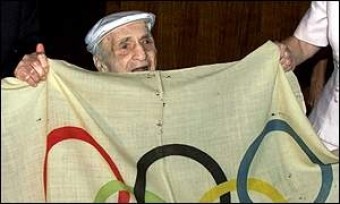The First Olympic Flag Went Missing for 77 Years After the 1920 Games Until a 1920 Olympian Revealed He’d Had It In His Suitcase The Whole Time
 Today I found out the original Olympic flag was missing for 77 years until 1920 Olympian Hal Haig Prieste revealed he’d had it the whole time.
Today I found out the original Olympic flag was missing for 77 years until 1920 Olympian Hal Haig Prieste revealed he’d had it the whole time.
The year was 1920. The Summer Olympics were being held in Belgium in the city of Antwerp. At the end of the Olympic Games, the flag suddenly went missing.
Fast-forward to 1997 and 101 year old bronze medalist Hal Haig Prieste, who won his medal in 1920 for platform diving, was being interviewed at a U.S. Olympic Committee dinner. During the interview, the reporter happened to mention the missing flag to Prieste, who then shocked everyone by stating, “I can help you with that. It’s in my suitcase.”
Prieste went on to reveal that he had been dared by fellow diver Duke Kahanamoku to climb the flag pole and steal the flag, which he did. He then folded it and put it in the bottom of his suitcases, where it remained some 77 years until he decided to reveal he had it at the dinner. His reason for finally revealing he had it? “I thought I ain’t going to be around much longer – it’s no good in a suitcase… I won’t be able to hang it up in my room.”
Prieste returned the flag to the IOC three years later during the 2000 Olympics. It was in reasonably good shape, thanks to the fact that it had stayed protected all those years in the bottom of his suitcase. The only real damage to it was that the edge was a little tattered from when he tore it off the flag pole. The Olympic Committee went about restoring the flag and put it on display in the Olympic Museum in Lausanne, Switzerland. They also gave Prieste a plaque thanking him for “donating” the flag that he had stolen from them all those years ago.
Bonus Facts:
- Besides being an Olympian, Prieste also was one of the Keystone Cops (a group of incompetent cops featured in various silent films). All total, he appeared in 25 films, including some with Charlie Chaplin. He also found work on Broadway, in a traveling circus as a comedian, and later in a traveling ice skating show, Ice Follies.
- On his way to the Olympics in 1920, Prieste stated that the ship he was on was full of mostly caskets, which were being sent over to Europe to be used to return the bodies of American soldiers killed during WWI that hadn’t been sent back yet.
- Despite the fact that the 1924 Olympic flag that replaced the original Antwerp flag first flew in Pairs, it was still called the “Antwerp Flag” and was used until 1988 when it was retired at the Seoul games. It was also used for the Winter Olympics until 1952 when a separate flag for the Winter Games was made.
- Up until 1994 (and beginning in 1924), the Winter Olympics were held a few months before the Summer Olympics. In 1994, it was decided to change this so that the two events would be two years apart.
- The Olympic Games have been more or less played like clockwork since their modern inception, with the exceptions being in 1916, 1940, and 1944, due to WWI and WWII.
- Up until the year 2000 (going back to 1928), the front of Olympic medals would always include the image of the goddess of victory, Nike, holding a winner’s crown in her right hand and a palm in her left. The backside of the medals then changed based on who was hosting the games that year. After 2004, this changed to Nike flying into the Panathenaic Stadium in Athens.
- In the 1908 Olympics, you could compete in the noble and ancient sport of Motor Boating…
| Share the Knowledge! |
|





2 comments